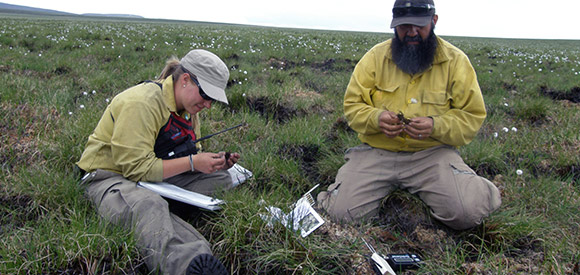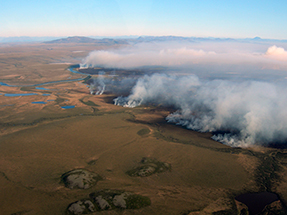In 2010, Noatak National Preserve had a record number of fires. At least 37 fires burned more than 106,000 acres in the preserve. After the record number of fires burned in Noatak during 2010, the NPS Alaska Region fire ecology program assessed the effects of burn severity on vegetation; and the age of carbon burned in these fires.
Initial results from the carbon dating show that the 2010 fires primarily consumed organic soil material that was less than 60 years old.

NPS / Jennifer Barnes
Fire sweeps across the tundra during a dry summer and one year later, cotton-grass tussocks bloom vibrantly. In 2010, Noatak National Preserve had a record number of fires. At least 37 fires burned more than 106,000 acres in the preserve. Tundra fires are relatively common in the Noatak National Preserve. These fires can burn into the organic soils which can impact vegetation succession and have the potential to release ancient stored soil carbon. After the record number of fires burned in Noatak during 2010, the NPS Alaska Region fire ecology program assessed: 1) the effects of burn severity on vegetation; and 2) the age of carbon burned in these fires.
The fire ecologist and crew measured burn severity and vegetation composition at five of the 37 fires that occurred in Noatak. In most areas monitored, the burn severity was low to moderate. As a result, the cotton-grass tussocks were re-sprouting vigorously and low shrubs such as Labrador tea, low-bush cranberry and dwarf shrub birch were also re-sprouting.

NPS / Dan Stevenson
These fires also provided an opportunity to study the impact of burn severity of fires on carbon emissions. Staff collected data to determine the age of the carbon that may be burned in tundra fires in Noatak. Initial results from the carbon dating show that the 2010 fires primarily consumed organic soil material that was less than 60 years old. This implies that given enough time, the carbon released from tundra ecosystems during wildfires will mostly recover though vegetation succession. However, soil carbon ages are consistently older in soils from high-severity burns where more of the organic material is consumed, and from areas that have burned more than once over the past 60 years. Preliminary data indicates that organic soils that are burned severely or multiple times may be as old as 900 years.
Results from this study have helped determine how the severity of fires can influence the vegetation recovery and the age of carbon burned in tundra fires. Based on mapping and monitoring, these recent fires appear to not be burning severely, which may help reduce the loss of ancient stored carbon. A final report is targeted for completion in 2013.
Contact: Jennifer Barnes, Regional Fire Ecologist
Email: Jennifer_Barnes@nps.gov
Phone: (907) 455-0652
Last updated: February 3, 2015
